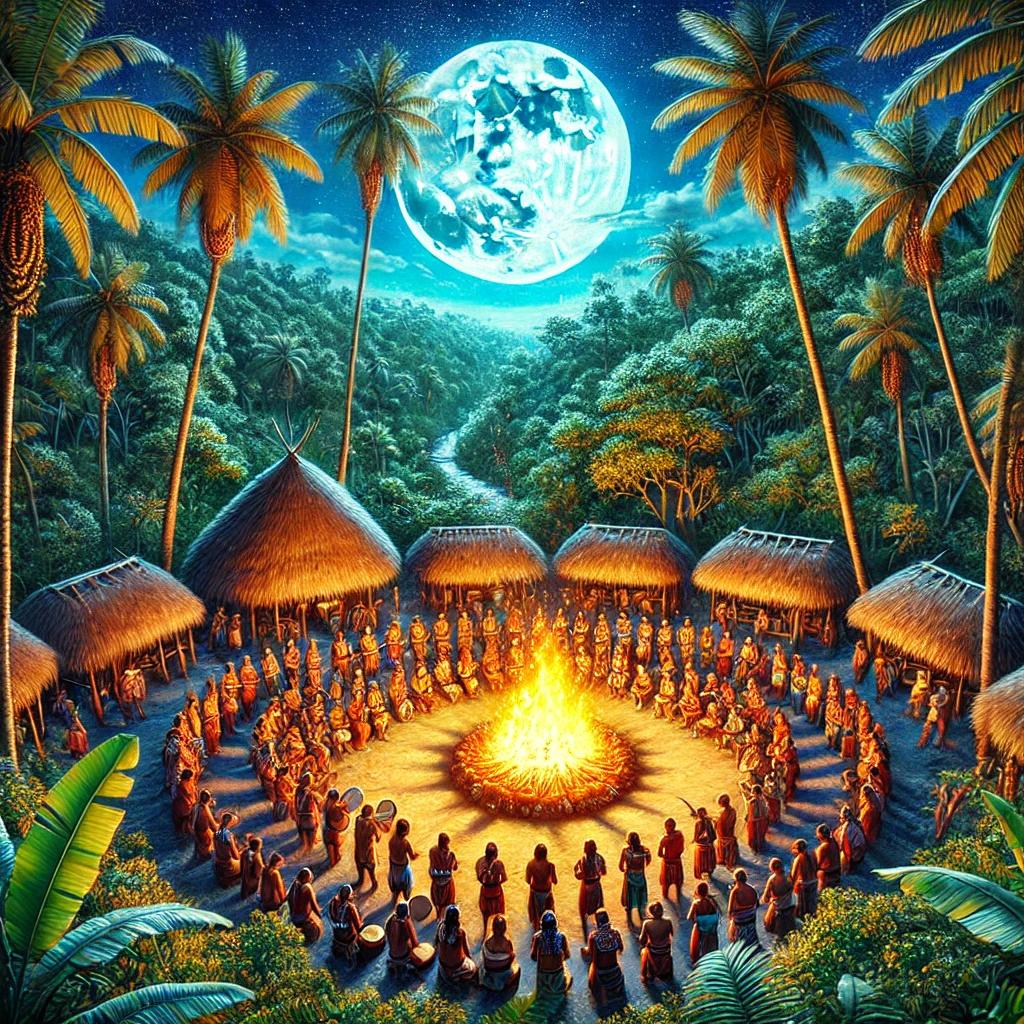Forest People, FOREVER THE FOREST
Ancestral Wisdom and New Year’s Traditions in the Amazon Rainforest
Nature’s Calendar: How Amazonian Tribes Mark Time and Transition
In the lush expanse of the Amazon rainforest, Indigenous communities celebrate the passage of time with ceremonies deeply rooted in ancestral wisdom. These rituals are not merely celebrations of a new calendar year but profound acknowledgments of cycles in nature, life, and spiritual alignment. Indigenous tribes like the Huni Kuin, Yawanawá, and Ashaninka carry out unique New Year’s traditions that reveal their rich connection to the land, cosmos, and spiritual dimensions.
Time and Its Cycles in Indigenous Worldviews
For many Indigenous peoples of the Amazon, time is cyclical rather than linear. The concept of a “New Year” does not always align with the Gregorian calendar. Instead, their transitions are often marked by environmental cues, such as the changing seasons, the rise and fall of rivers, and the life cycles of plants and animals. The Huni Kuin, for example, consider the flowering of certain trees or the arrival of specific bird species as a sign of renewal.
The Yawanawá people observe the end of a cycle by aligning their ceremonies with the rhythms of nature, a practice deeply tied to their cosmology. For them, these moments of transition are not about leaving the past behind but about integrating lessons learned while welcoming renewal.
Ceremonial Preparation: A Sacred Gathering
Preparation for New Year’s rituals begins days or even weeks in advance. Communities gather to cleanse their spaces, prepare sacred objects, and create offerings. This is a time for collective effort, with everyone participating—from the elders who impart wisdom to the younger generation to children learning their first chants.
A key element in these preparations is the making of sacred medicines such as rapéh and ayahuasca, which play a central role in ceremonies. The Katukina, known for their mastery of rapéh, prepare special blends for these occasions, believed to clear the mind and align the spirit with cosmic energies. These rituals are often accompanied by fasting, which is considered a way to purify the body and connect more deeply with the spiritual realm.
New Year’s Eve: The Rituals of Transition
On the night of the transition, Indigenous ceremonies unfold with an atmosphere of reverence and unity. The Huni Kuin hold ceremonies that involve chanting sacred songs (huni meka), dancing, and sharing ayahuasca, also known as nixi pae. This sacred brew is used to open spiritual portals, allowing participants to connect with ancestors and seek guidance for the coming year.
The Yawanawá, similarly, engage in uni ceremonies (their term for ayahuasca) to reflect on the past year’s challenges and blessings. These ceremonies are held in the shuhu, the communal house, which becomes a space of transformation. Participants gather around a central fire, which symbolizes the life force and connection to the spiritual world.
The Ashaninka, known for their harmonious relationship with the forest, integrate plant rituals into their celebrations. They use mapacho (wild tobacco) to cleanse and protect, blowing its smoke as an offering to spirits. This act is a call for balance and harmony in the coming cycle.
Storytelling and Transmission of Knowledge
Storytelling is a vital component of these ceremonies. Elders recount myths and teachings that illuminate the cycles of life and the interconnectedness of all beings. For the Tukano people, stories of the universe’s creation and the role of celestial bodies are shared, reinforcing their understanding of time as a dance between earthly and cosmic forces.
These narratives are not just entertainment but lessons that guide participants in navigating life’s transitions. They are often accompanied by sacred music played on flutes, rattles, and drums, instruments believed to carry the voices of spirits.
Dancing as a Bridge to the Spiritual World
Dance holds a special place in Indigenous New Year’s rituals. For the Yawanawá, the mariri dance is an expression of joy and gratitude, performed to honor the spirits and invite prosperity. Participants wear elaborate headdresses made of feathers and body paint drawn from jenipapo and urucum, natural dyes that carry symbolic meanings.
The Huni Kuin incorporate the pajé’s (spiritual leader’s) guidance in their dances, creating movements that reflect the stories being told and the intentions for the coming year. Through synchronized steps and chants, they invoke protection, health, and abundance.
The Role of Sacred Medicines in Renewal
The use of sacred medicines like rapéh, ayahuasca, and sananga is central to these ceremonies. The Katukina and Matsés tribes are particularly renowned for their sananga eye drops, which are used to enhance vision—not just physically but spiritually. During New Year’s ceremonies, these medicines help participants cleanse their energy and align their intentions.
Rapéh, a finely ground blend of plants, ashes, and seeds, is administered through kuripe or tepi applicators. This practice clears the mind, removes negative energies, and fosters a sense of grounding. The deep connection to these medicines is a reminder of the forest’s role as a source of healing and wisdom.
Symbolic Offerings and Prayers
Offerings are an integral part of New Year’s traditions, symbolizing gratitude and reciprocity. The Huni Kuin create mandalas with flowers, seeds, and leaves, arranging them in intricate patterns that represent balance and harmony. These mandalas are later returned to the earth as a gesture of respect.
Prayers are offered not only for the community but for the forest and its inhabitants. The Ashaninka, for example, chant invocations to Pachamama (Mother Earth) and celestial beings, seeking blessings for the preservation of their environment.
Dawn of the New Year: Unity and Gratitude
As the first rays of sunlight pierce through the forest canopy, the ceremonies draw to a close with collective expressions of gratitude. The new day symbolizes a fresh beginning, imbued with hope and renewed commitment to their spiritual paths.
Communities often share a communal meal featuring traditional foods such as cassava, plantains, and fish. This feast is not merely a celebration but a reaffirmation of their bond with the land and each other.
Lessons for the Global Community
The New Year’s traditions of Indigenous Amazonian tribes offer profound insights into living in harmony with nature and embracing the cyclical nature of time. Their rituals remind us of the importance of community, gratitude, and intentionality in transitions.
In a world increasingly disconnected from natural rhythms, these ceremonies serve as a powerful call to realign with the earth and recognize the sacredness of time. By honoring their traditions, we can learn to approach our own transitions with greater mindfulness and respect for the interconnected web of life.
The New Year’s rituals of Indigenous communities in the Brazilian Amazon, such as the Huni Kuin, Yawanawá, Katukina, and Ashaninka, are profound celebrations of renewal and continuity. These ceremonies transcend the boundaries of time, offering spiritual nourishment and a deeper connection to nature. As we reflect on their traditions, we are reminded of the timeless wisdom embedded in their ways of life—a wisdom that can guide us toward a more harmonious existence.
By shedding light on these practices and respecting their cultural significance, we not only honor their heritage but also contribute to preserving the Amazon rainforest and its guardians for generations to come.


